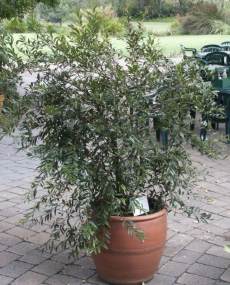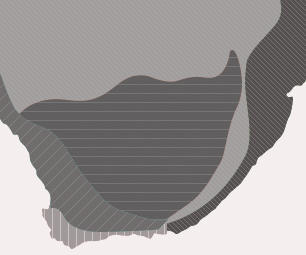Syzygium pondoense
Syzygium pondoense Engl.
Family: Myrtaceae
Common names: Pondo Waterwood, Pondowaterhout (A) umdoni wehlathi (Z)
SA Tree No: 558.1
Introduction
This attractive small tree is rare in nature. But it has great horticultural potential, despite its tongue twister of a name which is pronounced sigh-zig-ee-um pondo-en-see.

Description
Description
S. pondoense is a very rare shrub or a small tree that grows up to 3 m high.

The stem of this plant is single and grows up to 15 cm in diameter. It has reddish-brown bark when young which turns grey as it ages. New shoots and leaves are reddish in color. The leaves are shiny dark green but paler beneath. They are opposite with pairs at right angles and leathery. They are 3 - 10 mm in width. They have a conspicuous midrib on both sides. Side veins are fine and often reddish and more prominent below.

The flowers are white with a mass of stamens appearing in showy branched terminal heads. The flowering time is early summer. In early autumn, red to purple roundish fruits are produced. They are about 15 mm in diameter and are tipped with a persistent calyx.
Conservation Status
Status
This plant is assessed at RARE on the website redlist.sanbi.org (consulted 3 July 2015).
Distribution and habitat
Distribution description
It is often found in rocky beds of streams. It is endemic to the Northern Eastern Cape, but extends to southern KwaZulu-Natal.
Derivation of name and historical aspects
History
Myrtaceae (Waxberry family) is a family of woody plants with about five species that reach tree size in southern Africa. Members are characterized by simple, alternate and leathery leaves. The flowers are inconspicuous, naked and borne in dense axillary spikes. In the early years the fruits of some species were boiled to produce wax, hence the family common name.
The genus name of this plant 'Syzygium' is derived from the Greek "syzygos", meaning 'yoked together, referring to the paired leaves and branches. The species name 'pondoense' refers to its place of origin, which was known as Pondoland.
Uses
Use
The genus Syzygium has many medicinal properties. Eugeniin extracted from the buds of almost all species of this genus has antiviral activity against the Herpes simplex virus. Bark infusions of this plant are said to ease pain and coughing.

Growing Syzygium pondoense
Grow
The Pondo waterwood can be used in many ways. It is a good garden subject, especially in the rockery or wild fruit garden, because it attracts many bird species. Plant it in a sunny spot in the garden, but water well. With its reddish side veins and its colorful new leaves, it is a lovely ornamental plant. It is also an attractive container plant with its deep green, glossy foliage. Its weeping form placed in entrances makes a good focal point.
S. pondoense grows easily from seeds. Once the fruits are ready then the seeds should be collected quickly before birds come and enjoy themselves! Sow the seeds in a fine soil mix, cover them to ensure that they don't dry out. Make sure that you keep the media moist, but not wet, to induce germination. The correct time to sow seeds is autumn just after you have collected them. Fresh seeds have a high success rate. Rooting the cuttings of this plant is also very easy. Cuttings can be taken in autumn and rooted in pure river sand.
References
- Pooley, E. 1993, The Complete Field Guide to Trees of Natal, Natal Flora Publication Trust: Durban.
- Van Wyk, B. & Van Wyk, P., 1997. Field Guide to Trees of Southern Africa, Struik Publishers: Cape Town.
- Hutchings, A., 1996. Zulu Medicinal Plants, University of Natal Press: Pietermaritzburg.
Credits
Mhlonishwa D. Dlamini
Witwatersrand National Botanical Gardens
May 2002
Plant Attributes:
Plant Type: Shrub, Tree
SA Distribution: Eastern Cape, KwaZulu-Natal
Soil type: Sandy, Loam
Flowering season: Spring, Early Summer, Late Summer
PH: Acid, Neutral
Flower colour: White
Aspect: Full Sun, Morning Sun (Semi Shade), Afternoon Sun (Semi Shade)
Gardening skill: Easy
Special Features:
Horticultural zones










Rate this article
Article well written and informative
Rate this plant
Is this an interesting plant?
Login to add your Comment
Back to topNot registered yet? Click here to register.